PICKING A CUMMINS® ENGINE
Some preferences to consider include: fuel economy, horse power and torque, mechanical or electronically controlled fuel system, noise level, ease of installation, governed RPM limit, and purchase price.
Industrial/Commercial engines are not as conversion friendly as the Dodge® versions. Click here to read more.
THE 12-VALVE
All 12-Valves are non-electronic injection pump engines and DO NOT require any electronics from the truck to run. The simplicity of the 12-Valve engine makes it the easiest to install, maintain, and most dependable.
RPM RANGE
| 0-2500 | Bosch VE Rotary Pump 1989-1993 Stock Equipment ( most automotive applications ) Max Stock Torque - 400 ft./lbs. @1600 RPM |
| 0-2700 | Non-Modified P-7100 Pump 1994-1998 Stock Equipment Max Stock Torque- 440 ft. /lbs.@1600 RPM |
| 0-4000 | Modified Inline Pump (we make available) |
"Rotary Pump" 12-Valve
![]()
The 1989 - 1993 engines are readily available, inexpensive, get the best fuel economy stock, and have decent torque. These use the Bosch VE rotary pump which can be adjusted to achieve a little more horse power. The 1989 - 1991½ are non-intercooled. The 1991½ and newer are all intercooled. The non-intercooled engines can be intercooled if desired; it is highly recommended if you plan to turn the power up any to control exhaust temperatures. It's possible to add 40-60 HP with an inexpensive fuel pin so intercooling can be quite desirable.
The 1993 and earlier engines may have a diaphragm style vacuum pump, which does not work as well as the later style pump in the conversion. If you are planning to use an electronically controlled transmission, you should know that throttle position sensors are hard to come by for these, however, there are alternative sensor options available so it can be solved without much of a problem. The A/C compressor can also be an issue, as they are usually longer than the 1994 - 1998 versions, and may use a different mounting bracket. The vacuum pump and power steering mounting bracket will interchange. Sometimes the 1993 pumps and brackets are the same as the more conversion friendly 1994 - 1998 versions pictured below. In addition to these differences, some of the early engines have a different fan support that is higher and more centered with the engine. These fan supports work ok in the 1969 - 1997 trucks, although the fan is too high for the stock fan shroud it is at least centered. It does not work so well in the 1999 and newer trucks as the fan will not fit under the radiator shroud, and the shroud cannot be raised as easily as the older trucks. We have been told from a few customers that it works ok in the 2003 - 2007 6.0L diesel shroud. The older style fan hub does not work well if you plan on running a tachometer.
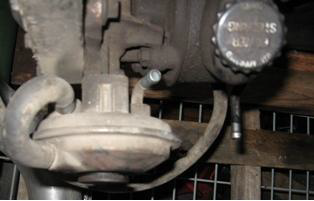 "Old" Style Diaphragm Vacuum Pump
|
 "New" Style Vacuum Pump |
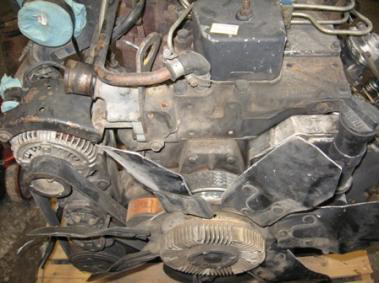 "Old" Style Fan Support Bracket and Water Neck |
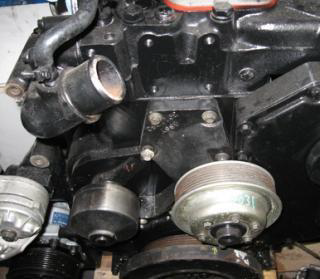 "New" Style Fan Support Bracket and Water Neck |
"P-Pump" 12-Valve

The 1994 - 1998 engines offer good power and torque, as well as good fuel economy. These engines have the Bosch P7100 inline manual fuel pump which produces 160-215HP stock. With this pump, one can easily add 15-95HP by installing a fuel plate. These engines are possibly the most desirable 12-Valves because power upgrades are easily accomplished with fuel plate adjustments etc. If you get an extremely good deal on an earlier engine it may be cost effective to convert it to a P7100 pump if you like.
There are many horse power upgrades that can be done to any of the 12-Valve engines without totally sacrificing fuel economy or reliability.
When using a Ford® radiator that has the upper radiator connection on the passenger side, it is helpful to replace the thermostat housing with the housing we offer; it points straight up, so it makes the upper radiator hose connection easier. It includes a new thermostat and seals. When using this housing you will also need our Dodge alternator bracket. Radiators that have the upper hose connection on the driver side utilize the "new" style thermostat housing that points to the driver side of the truck.
THE 24-VALVE
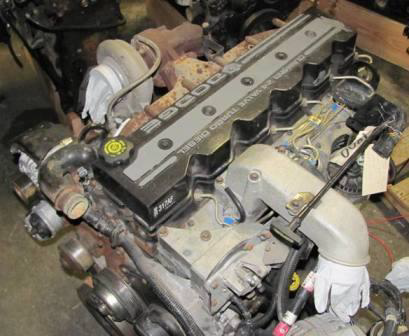
RPM RANGE
0-3200, Max Stock Torque—505 ft./lbs. @ 1600 rpm
The 1999½ - 2002 Cummins 24-Valve engines are computer controlled and provide a bit more horsepower than the earlier engines. For this engine we provide wiring instructions to help you make it run in your Ford or Chevy. You do not need the Dodge PCM to use this engine, it is also not necessary for OBDII diagnostics but requires a professional grade scan tool when using the OBDII diagnostic connector. Without the Dodge PCM, diagnostic information can still be accessed at a Cummins dealer through the Cummins data link connector located in the engine wiring harness, but certain performance programmers will not work as a result.
Be prepared to use the Auto trans style Cummins ECM when adapting the 24-Valve Cummins to an automatic transmission. Apparently there is a difference in how the ECM adjusts fueling depending on the idle load. When a standard trans style ECM is used with an Auto trans the engine may lope (run rough) at idle. This issue seems to be even more evident when high performance upgrades are added.
The 2001-2002 engines require an electronic speed signal input to run properly. Ford trucks that have a rear axle speed sensor can easily accommodate this, and it can be done in an older truck with an aftermarket speed sensor. It’s just another thing you need to know.
Be aware that some of these engines have what is referred to as a "53 block." This number is cast onto the side of the block just above the oil pan rail on the rear driver’s side or front passenger side. These blocks are known to crack on the exterior water jacket.
The thermostat housing on these trucks also points toward the driver’s side of the truck, so if you plan to run a Ford radiator that has the upper hose connection on the passenger side of the radiator, you will want to buy our straight up thermostat housing to make your upper radiator hose connection easier.
DCS also offers a "Stand-Alone" wiring harness to make your Cummins 24-Valve run in any chassis of your choice by simply adding power and ground.
To determine which 24-Valve engine you have, please reference your Cummins MAP sensor connector. See reference below:
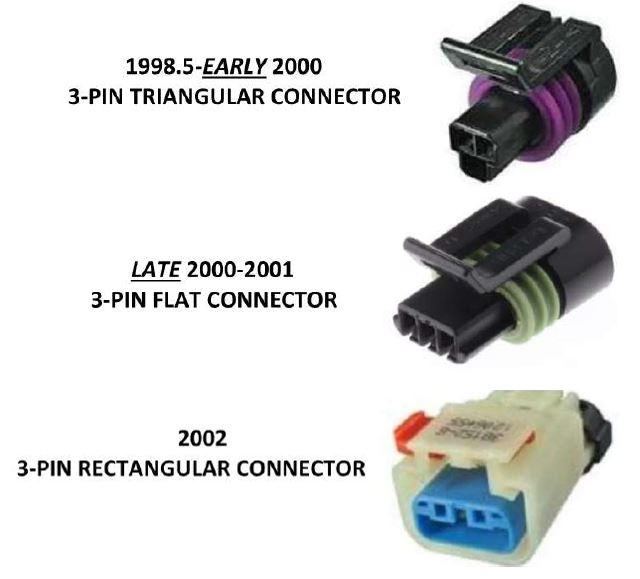
THE "COMMON RAIL"
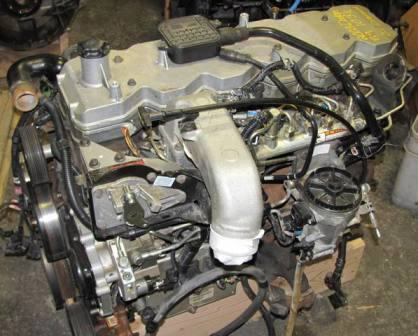
RPM Range
0-3200, Max Stock Torque- 610 ft/lbs @ 1,600 rpm
The 2003 – 2006 24-Valve engines are excellent engines. They are referred to as the ‘Common Rail’ engine because their injection pump pressurizes a single fuel rail that supplies the six individual electronic controlled injectors. These engines have relatively high horse power to begin with (usually starting at 305 HP) and have decent fuel economy as well.
These are the engines that are known for being ‘quiet’. They do not need the Dodge PCM to run in your truck, only the engine control module that is bolted to the side of the motor. There is a bit more wiring required when using one of these engines in a conversion, but we do most of the work by modifying your truck's existing engine harness to ‘plug into’ the Common Rail. These engines require an electronic speed signal, just like the 24-Valves.
Many of these engines have a Security Key Immobilizer Module (SKIM). This module prevents the engine from starting in a theft condition, and it can cause issues when installing the engine in a different truck. There are many options available to deal with this problem.
The 2003 – early 2004 common rails that were in front of an automatic transmission are best suited for conversions, due to their cable operated Throttle Position Sensor (TPS). This type of sensor has two important advantages; it easily accommodates the use of a cable operated cruise control servo, and gas engine type accelerator pedals, which can be easily bolted into the diesel equipped trucks. We also offer pedal bracket kits for 2003-2010 Ford Super Duty trucks with adjustable or fixed pedals.
2003 – Early 2004 (305 HP) Manual Trans Equipped Engines – These engines use a different cable operated TPS. They can be modified to accept a cruise control cable, but it takes a bit of work. The Ford accelerator pedal also works fine with the manual TPS cable.
2003 and early 2004 Automatic Transmission Equipped Throttle Position Sensor (TPS)
Most 2004 ½ (325 HP) and 2005 – Newer Engines – These engines use a fly-by-wire accelerator pedal. They also use an in tank transfer / lift pump. There are many options to consider when using one of these engines, give us a call or email and we can help you.
You can use the engine the way it is, but the SKIM and cruise control pose unique challenges. If you stay with the original electrical system, you will have to install the Dodge gas pedal in your truck. Whatever you do, you will need a lift pump of some kind. Use the early common rail lift pump / filter, use your Ford pump(s) and a bypass regulator, or buy an aftermarket performance lift pump system that is designed for the '05-'06 Cummins.
2006 5.9 – Newer 6.7 Common Rail – In stock form this engine is not what we would call ‘conversion friendly’. It has the same problems the 2005 and 2006 engines have regarding cruise control and security issues. Other issues are EGR concerns and differences in the intake plenum and turbocharger. It is possible to use the engine as is if you have the VIN number of the Dodge truck the engine was originally in and the modules. It is also necessary to use the Dodge accelerator pedal.
If you are considering a 6.7, for more options and information.
Industrial Cummins Engines
We offer this information to make you aware there can be many differences between an Industrial Cummins engine vs. a Dodge Cummins engine. The cost and time switching these engines over can be substantial.
1989-1993 Engines
These sometimes have a different injector pump (LUCAS) that does not work well in auto applications- if the pump is not a Bosch VE (Rotary) it will have a different front ‘timing’ cover and most likely a different pump gear as well. 1989-1990 engines were not intercooled. Even if your engine was intercooled the turbo outlet and inlet can be different. Other parts that differ on industrial/commercial Cummins engines are:
- Throttle linkage and cable
- Lower rad hose connection, a/c pump bracket
- Fan support/pulley
- Thermostat housing/alternator mount
- Belt tension bracket
- Oil pan and pickup tube (too long of a sump)
- Exhaust manifold
- Air horn
- Sometimes these even have lower compression pistons than the automotive versions
1994-1998 Engines
These engines may have different fuel and governor calibrations, and also have different parts such as the following:
- Injector pump with no tapped holes for Dodge style throttle linkage
- Throttle linkage
- Lower rad hose connection, a/c pump bracket
- Fan support/pulley
- Thermostat housing/alternator mount
- Belt tension bracket
- Oil pan and pickup tube (too long of a sump)
- Exhaust manifold
- Air horn (Intake)
- Sometimes these even have lower compression pistons than the automotive versions
1999-2002 Engines
-- Injection pumps don't work with Dodge electronics!
- No engine performance or "tuning" capabilities
- Much lower governed RPM is common (as low as 1,900 RPM!)
- fly-by-wire TPS (throttle position sensor incorporated in the accelerator pedal)
- Lower rad hose connection, a/c pump bracket
- Fan support/pulley
- Thermostat housing/alternator mount
- Belt tension bracket
- Oil pan and pickup tube (too long of a sump)
- Exhaust manifold
- Air horn (Intake)
- No factory engine diagnostics unless you have Cummins Insight®
Options:
Use a mechanical injection pump from a 1994 -98 Dodge 12-Valve engine known as “P-pumping” the 24-Valve engine
Get ALL of the DODGE electronic engine components (VP44, ECM, PCM, TPS & throttle cable)
Keep the existing engine components and sacrifice functionality of the converted vehicle
2003 and newer
Our adapter plates will not work with an industrial version engine from 2003 and newer. These engines use a rear gear drive system and the adapter connection is totally different.
*Diesel Conversion Specialists® is not affiliated with Cummins, Ford, or Dodge. Our uses of these trademarks are for descriptive purposes only.
Diesel Conversion Specialists
www.dieselconversion.com
406.755.8878
